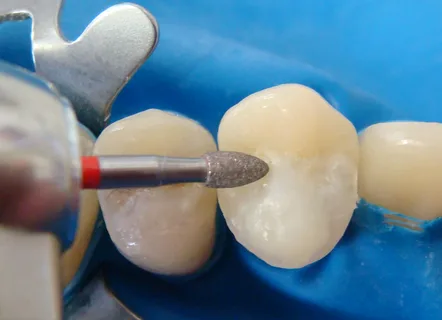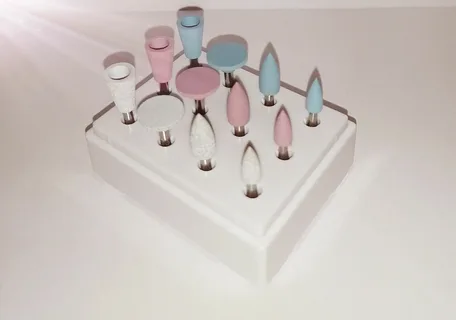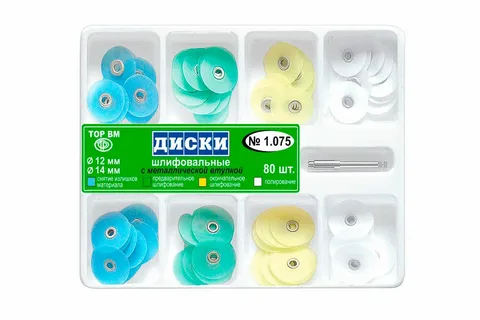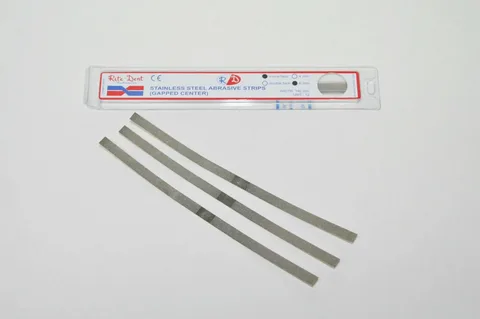Tools for Finishing Restoration Work
Machine translation
Original article is written in RU language (link to read it).
Different authors suggest various algorithms for the final finishing of restorations and prefer different types of tools; there is no consensus on the advantages or disadvantages of individual tools or techniques. Some experts call the combination of carbide burs and discs the gold standard for final finishing, while other authors recommend preferring diamond burs in combination with silicone polishers of various abrasiveness.
Learn all about the final adjustment of restoration at the webinar Techniques for Final Restoration Processing.
Each doctor, in the course of their professional activities, trying various materials and tools in their work, independently chooses the most optimal combinations in their opinion. In this article, we will consider general information about various types of tools that can be used for the final finishing of restorations.
Diamond Burs
These are the most popular tools used for the final processing of restorations. Diamond burs can be used with both attachments, turbine and angle. Burs for angle attachments are used at a micromotor speed of 150-200 thousand revolutions per minute.

Figure 1. Diamond bur for finishing.
Diamond burs used for finishing are equipped with red, yellow, or white color markings, which indicate the average particle diameter of the abrasive. Tools with red shank markings are primarily used for contouring, initial filling shaping, while tools with white and yellow markings are used in the polishing stage of restorations.
It is worth noting that green and blue shank markings indicate high abrasiveness of diamond burs, such tools are suitable exclusively for the tooth preparation stage.
A wide range of configurations of working parts of diamond burs ensures ease and simplicity of their use for any surfaces and teeth. The abrasiveness of these tools is determined by the diameter of diamond grit particles, which are sprayed onto the metal shank in one or more layers.
The durability and cutting characteristics of diamond burs depend on the following factors:
- the production technology of coating the shank with diamond grit particles and their distribution over the working area;
- the techniques of their operation and processing.
Diamond burs require mandatory water cooling, as the absence of water during their use leads to a rapid loss of cutting qualities of the tools, as the gaps between the cutting edges get filled with detritus. Also, neglecting water cooling causes overheating and destruction of the binding compound, the finest diamond particles are lost, and the tool becomes "bald".

Figure 2. Final finishing of the seal.
In the final stage of finishing using diamond burs, special care is required to avoid forming grooves on the surface of the restoration. It is not allowed to apply pressure on the diamond burs more than 0.5 N.
Tungsten Carbide Burs
Carbide or tungsten carbide tools are a popular alternative to diamond ones. They can also be used with both types of handpiece tips, turbine and angle. Tungsten carbide is the material that provides the cutting ability of these tools.
The following types of carbide burs are distinguished:
- solid,
- combined, where the carbide head is welded to a metal shank.
Tungsten carbide burs are coated with a special coating to prevent corrosion, and many manufacturers recommend avoiding contact of the tools with hydrogen peroxide. Prolonged interaction of these burs with hydrogen peroxide significantly deteriorates their performance and leads to tool failure.
The abrasiveness of carbide burs is determined by the number of edges, which can vary from 8 to 30.
The cutting edges of the tool can be oriented spirally or linearly relative to each other, depending on the manufacturing technology.
Carbide burs with 8 to 10 edges on the working part are used for contouring restorations. Burs with 12-16 edges are suitable for the stage of forming a filling, with 30 – for polishing.
In the form of a cone, tools are equipped with rounded atraumatic tips, which ensures safety of use in the gum area.
The principle of working with carbide burs involves the correct positioning of the tip, moving it from the restoration to the tooth tissues. This makes it easier and lighter to achieve a perfectly smooth surface of the restoration, and also minimizes the risk of damaging healthy tooth tissues.
Zirconia-fiber burs
These tools are used only in the angle handpiece; they consist of a 14-micron diameter fiberglass enriched with zirconium, surrounded peripherally by a composite composition. Another name for such burs is ceramo-fiber.
The risk of injuring surrounding soft tissues with zirconia-fiber burs is minimal. They are completely safe for tooth tissues, and the abrasiveness of ceramo-fiber burs is only several times higher than that of standard toothpaste.
Indications for the use of zirconia-fiber burs:
- polishing surfaces after professional hygiene;
- super polishing and polishing of restorations made of composite;
- final polishing of teeth after removal of braces in orthodontics;
- final polishing of roots in periodontology.
It is also worth mentioning the high wear resistance of zirconia-fiber tools; they do not fray under load, which is typical for regular fiberglass, and their cost is comparable to that of carbide burs.
Polishing Stones
Another type of device for the final finishing of restorations. Their working surface features a solid head made of silicon carbide or aluminum oxide.
Polishing stones are available in the following varieties:
- dark green, characterized by increased abrasiveness, suitable for the stage of filling formation;
- white – ideal for polishing fillings made from any dental materials.
Depending on the shape of the working head, polishing stones serve different purposes:
- flame-shaped – for polishing vestibular surfaces, cervical and interproximal areas;
- rounded and pear-shaped – for processing palatal and occlusal surfaces.
These tools are reusable provided they are used correctly, and high pressure should not be applied when working with polishing stones.
Silicone Polishers
Popular in aesthetic dentistry, these devices are used for the final finishing of completed restorations. The head of the polisher is made from polyurethane or silicone of various densities, into which an abrasive filler is incorporated. The most popular shapes of polishers are as follows:
- flame,
- cup,
- disk.

Figure 3. Silicone polishers.
Polishers in the shape of a cup or a large flame are universal; they can be used for processing any surfaces, a small flame is suitable for the chewing surface, and a disk-shaped polisher is for the vestibular surface.
Disks
These are versatile tools that can be used for various purposes: contouring, polishing, filling formation. They are convenient for working on both textured and smooth surfaces.
Abrasive can cover both or just one surface of the disc, with aluminum oxide predominantly used as the abrasive. The discs are used in conjunction with plastic or metal disc holders, which are attached to the angle head.

Figure 4. Dental discs.
Small diameter discs are convenient for working in the cervical area, while a larger diameter is suitable for processing vestibular surfaces. Discs are disposable tools that are not subject to sterilization.
Strips
Another device necessary for the finishing touches of restoration. They are available in the following types:
- metal-based,
- polyethylene-based.
In therapeutic dentistry, the use of metal strips is impractical as they are highly abrasive, not very flexible, and highly traumatic. Strips based on polyethylene are flexible, thin, and available in various abrasivities and widths.

Figure 5. Dental strips.
Aluminum oxide is the most common abrasive, but there are also narrow strips coated with diamond grit available on the market, which can be used during the initial contouring of the restoration on the contact surface.
The working principle: the strip is tightly pressed against the surface of the tooth or restoration and gentle reciprocating movements are made in the buccal-oral direction, it is important to avoid damaging the gums, destroying the formed contact point. Strips are disposable devices that cannot be sterilized.
The author's three-step polishing protocol to a dry shine in the webinar Final Restoration Processing.


